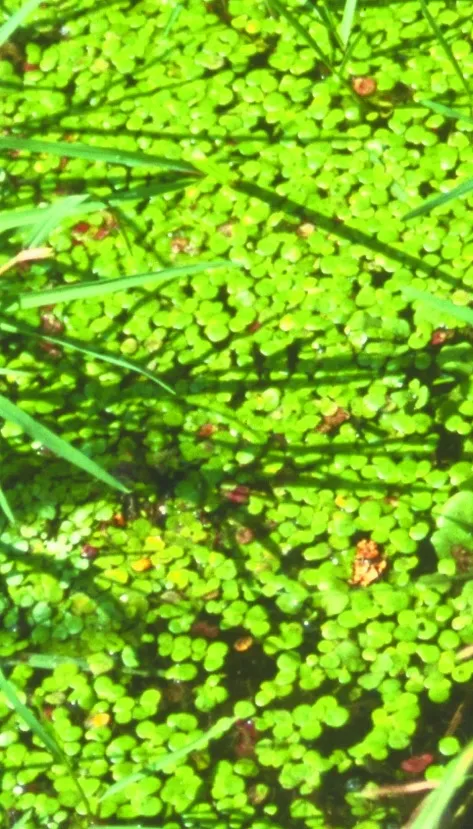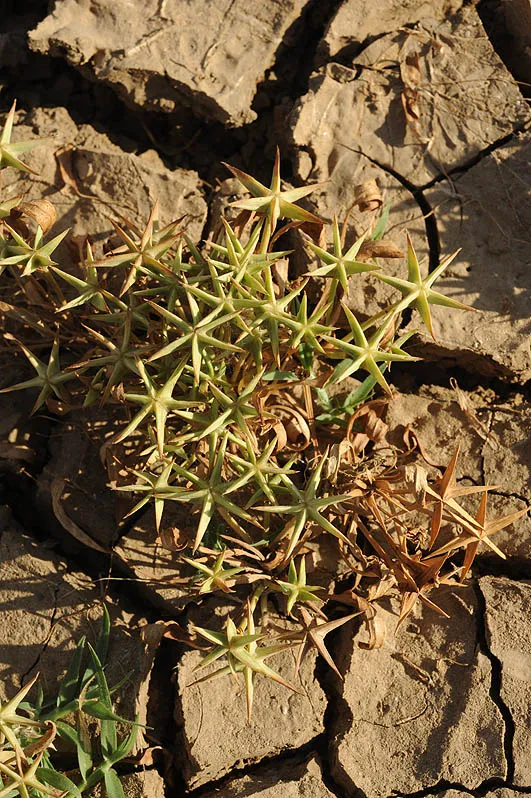Greater Duckweed, Common Duckweed
Spirodela polyrhiza

Spirodela polyrhizais a tiny plant that
floats on the water surface and occasionally forms a
continuous mat. The plant’s shoot is termed a
thallus and is shaped like a small leaf, thick and
flat, disc-shaped, 6-8 mm across. Its underside is purple. A number of roots extend
from the thallus below the water surface. The plants grow alone or in
groups. Reproduction is predominantly vegetative, by budding in
lateral pouches on the thallus. The buds develop roots after
detaching from the mother plant. The plant is bi-sexual, with tiny
flowers. The inflorescence is enveloped in two spathes; each
inflorescence has two male flowers and one female flower. Flowering
is very rare. In temperate zones, when the cold season begins, thicker, dark
green to brown rootless buds known as turions are produced. The buds
sink to the bottom and lay dormant until they germinate into new
plants the following season. Spirodela polyrhiza spreads easily but also
disappears rapidly from sites it grows in, and occasionally its presence is
only episodic.
In the United States Spirodela is cultured and grown for fodder, as a substitute for alfalfa. Its high fat and protein content provide the species with great nutritional value. Spirodela is also used to purify water, thanks to its high capacity for absorbing pollutants from the water.
Spirodela grows in the Golan and the Kinarot Valley. It had been previously known from the Sharon in three locations – Batih Pond, the Wadi Poleg marshes and near Hakfar Hayarok, but has not been found on the Coastal Plain since 1957. In the Golan it has been collected a number of times in the Zavitan Stream, and is regularly seen in the Bet tsayda Valley – in the Meshushim (Zaki) and the Dalyot ( Maǧrase) lagoons. It has been observed in a washtub at Kibbutz Gonen (Hula Valley) in 2004 by Shauli Beckerman. In 1995 it was collected at the Tuba – Zangariye Springs west of the mountainous Jordan area.
On the water surface in fresh water bodies and in marshes.
genus Spirodela belongs to the Lemnaceae family, which includes a number of genera whose shoots are thalli that float on the water surface in fresh water bodies. The closest genus to is Lemna, and Spirodela polyrhiza was once considered as a species of Lemna. Spirodela has four species in the species, all cosmopolitan.
• The drying up of water bodies, the reduction of the Kinneret’s water level, pollution and habitat loss due to development are the factors that reduced the number of sites, and are threatening the continued existence of population in surviving sites.
• Populations are very small and therefore endangered. The fragmentation between populations is local.
• The species is very rare in Israel, but has a broad global distribution and is apparently not in danger of extinction.
Management of the Dalyot and Meshushim lagoons to reduce the danger of falling water levels and maintenance of clean water by preventing cow and water buffalo grazing in the water where Spirodela polyrhiza grows; naturalization in water bodies in the Sharon –in the Ya'at Pond winter pond and in the Zeta Marsh.
The species has a broad global distribution, and is also found in countries located near Israel: Egypt, Syria-Lebanon, Turkey and northern Iran. It is not a peripheral species in Israel, since it is also grows in Egypt and south of it in East Africa.
A minute floating aquatic plant, very rare in Israel that has survived in a few sites in the Golan and the Kinarot Valley and is extinct on the Coastal Plain. Its main threat factor is the loss of water bodies due to their drying up and to dropping water levels. Has an extensive global distribution, and is not globally endangered.
ויזל, י. וליפשיץ, נ. (1971). צמחי מים בישראל – צמחים טבולים וטבולים למחצה. הוצאת רשות שמורות הטבע.
Current Occupancy Map
| 1000 squre meter pixel | 5000 squre meter pixel | 10000 squre meter pixel | |
|---|---|---|---|
| number of observations | 0 | 0 | 0 |
| in total pixels | 0 | 0 | 0 |
| Family | Lemnaceae |
| Classification | On the endangered species list |
| Ecosystem | Mediterranean humid |
| Chorotype | Cosmopolitan with preference to tropical and sub-tropical areas |
| Conservation Site | Bet tsayda Nature Reserve |
| Rarity |
1
3
6
|
|---|---|
| Vulnerability |
0
3
4
|
| Attractiveness |
0
0
4
|
| Endemism |
0
0
4
|
| Red number |
1
3.2
10
|
| Peripherality | 0 |
| IUCN category | DD EW EX LC CR EN VU NT |
| Threat Definition according to the red book | Vulnerable |
 Based on:
Based on:






